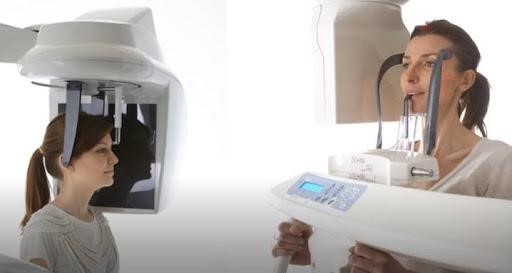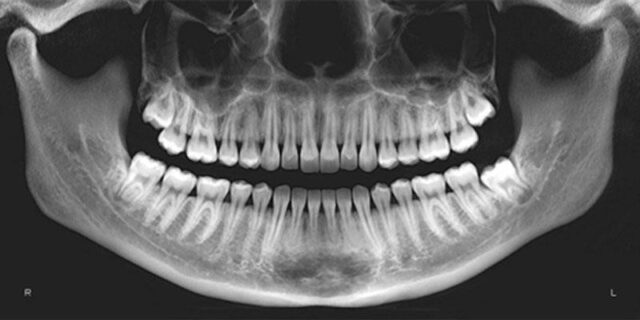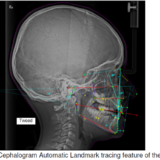Jaw Pain – TMJ
 If you notice popping, clicking, tenderness or pain in the jaw joints or ear when you chew, talk, yawn or simply open and close your mouth, then you may have symptoms of TMJ (tempero-mandibular joint disorder).
If you notice popping, clicking, tenderness or pain in the jaw joints or ear when you chew, talk, yawn or simply open and close your mouth, then you may have symptoms of TMJ (tempero-mandibular joint disorder).
TMJ disorder is usually caused by a disharmony with your jaw muscles or bite not being balanced or relaxed. Often there is heavy grinding or clenching of the teeth causing overuse of the jaw muscles. The grinding or clenching; is usually worse at night and the disorder can result in significant pain.
At AlTabeeb Dental we thoroughly examine all the possible causes of your TMJ disorder, provide you with detailed information about the condition and ensure that we provide you with appropriate measures to help treat your problem.
Symptoms Of TMJ
TMJ is often associated with one or more of the following symptoms:
- Jaw Sounds (popping, grinding or grating sounds)
- Chewing difficulties or discomfort
- Difficulties opening or closing the mouth
- Headaches, migraine or neck aches
- Jaw or facial muscle pain
- Locked jaw or stiffness
- Ear problems (aches without infection, ringing (tinnitus) or clogged ears)
- Worn or chipped teeth
- Tooth or gum sensitivity
- Dizziness
Causes Of TMJ
There are several conditions that may cause TMJ disorders, the most common being listed below:
Teeth Grinding Or Clenching
Also called bruxism. This can cause wear or damage to the jaw joint, teeth or any fillings/restorations. (e.g. crowns, veneers etc.). Studies indicate over 30% of the population has bruxism and 1 in 3 people damage their teeth during sleep, yet most are unaware that this is occurring. Our Al Tabeeb Dental doctors can accurately detect telltale signs of tooth wear. You may also awaken in the morning with jaw or ear pain.
Crooked Teeth
This may cause bite imbalances. You may have difficulty finding a comfortable bite or notice that the teeth have moved and the bite has changed. Fortunately we can often adjust your bite with a variety of methods such as orthodontics (Invisalign or braces) or a method known as bite equilibration.
Previous Dental Treatment
Such as old fillings or defective crowns can cause bite imbalances. We can carefully determine if adjustment or replacement of any unbalanced dental restorations is required.
Trauma
Previous accidents causing damage or fractures to the jaw or surrounding bones can lead to TMJ disorders.
Stress
This often leads to release of nervous energy by either subconsciously or consciously clenching or grinding teeth together. Often this can be controlled with a bite splint that you wear while you sleep. We will carefully assess if this is appropriate for your situation.
Chewing Habits
Such as excessive gum chewing, fingernail biting or frequent chewing of very hard or sticky foods may be associated with TMJ disorders.
Degenerative Joint Diseases
Such as osteoarthritis. This can be one of the most extreme causes of TMJ disorder. Jaw osteoarthritis can be a debilitating condition that may effect your teeth, gums and jaw bone structure. We will provide you with comprehensive information and treatment options or specialist referral if necessary.
Diagnosis Of TMJ
Since TMJ disorders have a wide range of symptoms and causes it requires thorough examination, investigation and diagnosis. Dental X-rays such as an OPG (orthopantomogram) or a CT scan can also help with diagnosis and treatment of your condition.
Treatment Of TMJ
Treatment usually involves conservative methods such as physical therapy, ice and heat therapy, relaxation techniques, anti-inflammatory tablets, muscle relaxant medications often in conjunction with a custom-fitted bite splint.
If you clench or grind, it is usually considered very beneficial to wear a custom-fitted bite splint while you sleep. Protecting the teeth and restorations with a professionally made bite splint is often regarded as one of the most important preventive dental methods available. Potentially thousands of dollars in future dental treatment could be saved with a bite splint.
The ‘MiniFM’ bite splint is a small, thin mouthpiece that fits snugly over the upper teeth and is very comfortable to wear.It is made of high strength composite material and provides excellent protection of teeth during sleep, when the forces of grinding or clenching are at their greatest.
As there are many causes of TMJ disorder other treatment methods may also be considered. Examples of these are: correction of bite abnormalities with orthodontics (e.g. braces or Invisalign), bite adjustment procedures or any necessary restorative dental procedures.
Dry Mouth
 At AlTabeeb Dental we understand dry mouth and have developed methods to help you better manage the condition, improve your oral health and the debilitating symptoms often associated with dry mouth.
At AlTabeeb Dental we understand dry mouth and have developed methods to help you better manage the condition, improve your oral health and the debilitating symptoms often associated with dry mouth.
What Is Dry Mouth?
Dry mouth, also known as xerostomia, is due to a reduction in saliva or spit you produce in your mouth. Saliva is a very important part of a healthy mouth and body. It has many important functions including mouth lubrication and digesting food. It acts as a natural cavity fighter by washing away food particles and bacteria whilst reducing the acidity that leads to decay in our mouths. There is also protective proteins, enzymes and minerals in saliva that helps to strengthen and protect tooth enamel to stop cavities from developing.
Symptoms
Reduced salivary flow or dry mouth can lead to many debilitating symptoms such as difficulties with speech, eating, bad breath (halitosis), tasting, swallowing and cracked lips. Your dental health can be severely compromised due to a greatly increased risk of tooth decay, gum disease and mouth infections. Some of these problems can be so severe that tooth loss may occur.
Causes
There are numerous causes of dry mouth such as many drugs or medications. In fact around six hundred drugs are responsible including antihistamines, high blood pressure medications, decongestants, sedatives, antidepressants and illegal drugs. Other related causes of dry mouth are diabetes, parkinson’s, hypertension, Sjögren’s syndrome, chemotherapy, radiotherapy, dehydration, mouth breathing, sleep apnea, hormonal changes, smoking and alcohol.
Treatment
At AlTabeeb Dental we take a comprehensive medical and dental history including assessment of the various medications, lifestyle factors or certain diseases that may be aggravating your dry mouth. We will assist you with many preventative methods such as quitting cigarette smoking, increased mouth hydration and customized oral hygiene measures. We also provide specifically tailored products such as specialized tooth pastes, mouth rinses, enamel remineralising agents, topical gels, saliva substitutes and specially formulated chewing gum.
Our aim at AlTabeeb Dental is to provide you with appropriate dry mouth information, strategies, products and relief measures tailored to your individual needs. We will also help prevent or actively repair any dental conditions or infections that may develop caused by dry mouth.
Diagnostic Radiology Services
 Oral radiology is the specialty of dentistry and discipline of radiology concerned with the production and interpretation of radiographic images
Oral radiology is the specialty of dentistry and discipline of radiology concerned with the production and interpretation of radiographic images
Our Radiology Service offers a variety of diagnostic imaging services including capture & interpretation of radiographic images and consultative services by our expert dentists.
- Certified and experienced dental assistants capture all 2D digital imaging.
- Periapicals, Bitewings, Occlusal, Panoramic, Cephalometric and Extraoral images for special circumstances
Our recently fitted Digital x-ray machine makes the x-ray procedure easier and safer than ever. With its new Tomosharp technology and powerful image processing, the new edition delivers outstanding image clarity & is the perfect unit for your routine imaging needs.
Two of our frequently used procedures for dental imaging include the OPG and the lateral Cephalogram
Panoramic Dental X-ray (OPG)

An OPG can be an extremely useful diagnostic tool for general dentists, oral surgeons, orthodontists, and other physicians who work with the teeth, mouth, and jaw. The OPG delivers a wide image of the patient’s jaw region on a single film. Essentially, this is a panoramic x-ray of the jaw and teeth which encompasses the front and sides.
OPG / Panoramic dental x-ray uses a very small dose of ionizing radiation to capture the entire mouth in one image. It is commonly performed in everyday practice and may be used to diagnose & plan treatment for dentures, braces, extractions and implants.
This exam requires little to no special preparation. Tell your doctor if there is a possibility you are pregnant. Remove any jewelry, eye glasses or metal objects that might interfere with the x-ray images. You will be asked to wear a lead apron to protect the rest of your body from any radiation exposure.
What is Panoramic X-ray?
Panoramic radiography, also called panoramic x-ray, is a two-dimensional (2-D) dental x-ray examination that captures the entire mouth in a single image, including the teeth, upper and lower jaws, surrounding structures and tissues.
The jaw is a curved structure similar to that of a horseshoe. However, the panoramic x-ray produces a flat image of the curved structure. It usually provides details of the bones and teeth.
An x-ray exam helps doctors diagnose and treat dental conditions. It exposes you to a small dose of ionizing radiation to produce pictures of the inside of the body. X-rays are the oldest and most often used form of medical imaging.
Unlike a traditional intraoral x-ray where the film/x-ray detector is placed inside of the mouth, the film for a panoramic x-ray is contained inside of the machine.
Lateral Cephalogram

Another useful assessment tool in dental imaging is the lateral cephalogram. This is an x-ray which generates a side view of the head that can provide important information about the teeth and jaw. The lateral cephalogram shows facial structure, bone, and soft tissue. Our Orthodontists can use these images to study the relation of your teeth to your jaw, assess problems in alignment or growth patterns, and prepare treatment.
The lateral cephalogram is best for observing jaw alignment. If you have an overbite or underbite, for example, these images will provide better detail and allow our Orthodontists to develop the best approach for your needs. This x-ray is commonly used in children to predict growth patterns in the teeth and jaws. The lateral cephalogram is used with adults as well, to study changes made from treatment or track other issues. This x-ray is also useful in tracking the progress of treatment.
What to Expect With a Lateral Cephalogram
Often, you’ll receive this scan in conjunction with the OPG. You will need to remove jewellery and metallics from your head and neck. For your lateral ceph you’ll be asked to keep your teeth together, and may lean your forehead against a steadying implement. The x-ray itself will be completed in only a few seconds.
